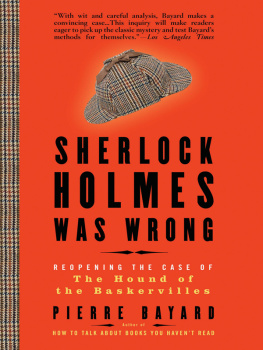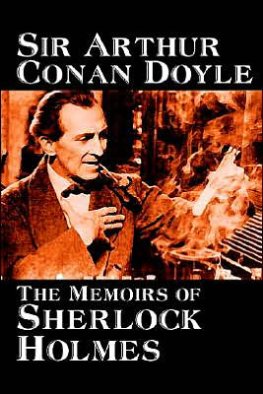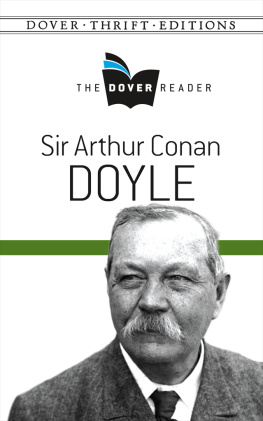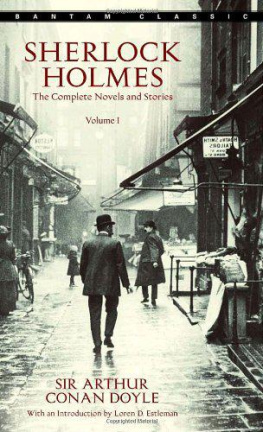Sherlock Holmes
Was Wrong
BY THE SAME AUTHOR
How to Talk About Books You Havent Read
Sherlock Holmes
Was Wrong
Reopening the Case of
The Hound of the Baskervilles
PIERRE BAYARD
Translated from the French
by Charlotte Mandell

Copyright 2008 Les Editions de Minuit
English translation copyright 2008 by Charlotte Mandell
All rights reserved. No part of this book may be used or reproduced in any manner whatsoever without written permission from the publisher except in the case of brief quotations embodied in critical articles or reviews.
For information address Bloomsbury USA,
175 Fifth Avenue, New York, NY 10010.
Published by Bloomsbury USA, New York
All papers used by Bloomsbury USA are natural, recyclable products made from wood grown in well-managed forests. The manufacturing processes conform to the environmental regulations of the country of origin.
LIBRARY OF CONGRESS CATALOGING-IN-PUBLICATION DATA
Bayard, Pierre, 1954
[Laffaire du chien des Baskerville. English]
Sherlock Holmes was wrong: reopening the case of the
Hound of the Baskervilles / Pierre Bayard; translated
from the French by Charlotte Mandell.1st U.S. ed.
p. cm.
Includes bibliographical references.
eISBN: 978-1-60819-244-1
1. Doyle, Arthur Conan, Sir, 18591930. Hound of the Baskervilles.
I. Mandell, Charlotte. II. Title.
PR4622.H63B3913 2008
823'.912dc22
2008032807
First published in the United States by Bloomsbury USA in 2008
This paperback edition published in 2009
1 3 5 7 9 10 8 6 4 2
Typeset by Westchester Book Group
Printed in the United States of America by Quebecor World Fairfield
For Guillaume
The barriers between reality and fiction are softer than we think; a bit like a frozen lake. Hundreds of people can walk across it, but then one evening a thin spot develops and someone falls through; the hole is frozen over by the following morning.
JASPER FFORDE, The Eyre Affair
Contents
Sherlock Holmes: English detective. Believed to be dead after his disappearance in the Reichenbach Falls, in Switzerland, he is resurrected by Conan Doyle, eight years later, in The Hound of the Baskervilles.
Dr. Watson: friend and colleague of the detective.
Sir Charles Baskerville: owner of the manor house that bears his name. Dies under mysterious circumstances just before the beginning of the novel.
Henry Baskerville: nephew of Charles Baskerville, heir to his uncles manor house and fortune.
Dr. James Mortimer: friend of the Baskervilles. Travels to London at the beginning of the novel to ask Sherlock Holmes to investigate Sir Charles Baskervilles death; he thinks the police brought their investigation to a close too quickly.
Jack Stapleton: naturalist living near Baskerville Hall. Sherlock Holmes discovers that he belongs to the Baskerville family and suspects him of being Charless murderer.
Beryl Stapleton: wife of Jack Stapleton. He passes her off as his sister.
John Barrymore: butler in Baskerville Hall.
Eliza Barrymore: wife of John Barrymore and sister of Selden.
Selden: escaped convict, brother of Eliza Barrymore.
Frankland: bitter old man who lives on the moor and constantly sues his neighbors. Father of Laura Lyons, from whom he is estranged.
Laura Lyons: daughter of Frankland and mistress of Staple-ton. Lives alone on the moor.
The hound: watchdog. Accused by Sherlock Holmes of two murders and one attempted murder.
The Devonshire Moors:
Dartmoor
FROM THE CHAMBER where she has been locked for hours, the young woman hears shouts and laughter rising from the great dining hall below. As the evening advances and talk becomes more heated under the influence of alcohol, her anxiety mounts at the thought of the fate intended for her by the men she can hear carousing below. First among them, worst of them all, is the leader of the gang, Hugo Baskerville, corrupt owner of the manor house that bears his name.
For months Hugo had been hovering around the young country lass, whom he had tried to attract by every possible means, first by trying to seduce her, then by offering her father large sums of money if he would agree to further their relationship. But she found him vile, repulsive; she kept avoiding him. So Hugo and his men, on this Michaelmas, have resorted to violence. While the girls father and brothers have been away, the have kidnapped her and brought her to Baskerville Hall.
When the bedroom door had first closed behind her, the girl had stayed motionless for a while, paralyzed by emotion. Now, overcoming her fear, she comes to herself and begins looking for a way to escape. First she tries to force the lock, but she soon abandons the idea. Made of metal and set into a massive oak door, it would be impervious to her blows.
A quick look around the room reveals that aside from an inaccessible chimney flue there is only one available opening: a little window, just large enough for a slender person to climb through. But leaning out, she sees that the ground is far below; jumping would mean breaking a limb, even killing herself.
But this opening is the only one that lets the prisoner entertain a faint hopeprovided she can show some nimbleness, and is willing to risk her life on one stroke of luck. There is ivy climbing the front of the house from the ground to the roof, and so she resolves, daring everything, to stretch out her arm, grab hold of it, and begin a perilous descent.

Having finally reached the ground, the young woman ignores her scratches and at once starts running away from the Hall and toward her fathers house, whose lights three leagues across the moor she can more intuit than glimpse.
Despite her pain and anguish, her hope begins to rekindle as she gets farther from her prison. She fights off the terror of the darkness and the eerie noises from the moor, a world inhabited by supernatural creatures, in this era not yet civilized by science.
These indistinct noises are soon dominated by a stronger, more regular sound approaching quickly. The origin is easy to recognize. It is a horse galloping along the path at top speed, urged on with shouts by its rider, and there can be no doubt about its target.
But whoever attentively lends his ear to the sounds of the moor will hear even worse. More terrifying than the noise of galloping hooves is the howling of a pack of dogs, the barking closer and closer, as if they were outrunning the horse and had already left it far behind.
The young woman realizes now that her jailer has found her missing and is in hot pursuit. But he wasnt content to ride after her. He also set the pack of hounds that he uses for hunting on her trail, probably after having them sniff a piece of clothing of the prisoner who is now their quarry.

Dropping from fatigue, dying of fright, the young woman has no choice but to abandon the path and hurl herself into a broad ravine, a goyal, marked long ago by the inhabitants of the place with two tall stones. She knows she has no chance of escaping her kidnapper; all she can do is gain a few minutes respite before she is discovered and torn apart by the hounds.
Next page















